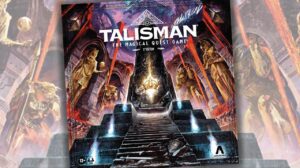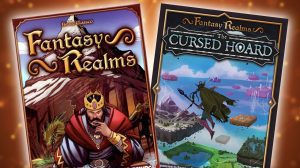Disclosure: Meeple Mountain received a free copy of this product in exchange for an honest, unbiased review. This review is not intended to be an endorsement.
From the chilling screams of my last horror board game review of Scream to reviewing yet another board game based on a horror property franchise on its deathbed! Fate has led me down a dark and unexpected path today, and we are delving into the heart-pounding world of Texas Chainsaw Massacre, where terror awaits at every corner if you are playing the Trespassers. For that one player sitting on the Sawyer family throne, they might have some new ingredients for the evening family BBQ if things go their way.
The Texas Chainsaw Massacre: Slaughterhouse is a One-versus-All experience armed with five different scenarios which all take place on the same farmhouse board. These scenarios are goals that the Trespassers will need to accomplish before they can escape. It can be something simple, like finding some car parts and gas, or something more complex, like taking photos of the place or gathering evidence. Meanwhile, the Sawyer family’s goal is to relentlessly pursue the Trespassers and slaughter them.

Plenty of Pig’s Blood Here
The Trespassers themselves don’t have any special abilities or asymmetrical powers. The only difference between them is their starting personal item, which can break a rule or two. Trespassers always get the first move at the start of each round, and the trespassers themselves decide on the turn order.
As a Trespasser takes their turn, they have four action points to spend. These points primarily serve the purpose of navigating the farmhouse, conducting item searches, or exchanging items with fellow Trespassers. However, the key to survival lies in an area that cannot be overlooked: generating noise. Each time a Trespasser ventures through a door, searches for items, ascends the stairs, or runs in a hurry, they inadvertently create noise.
This noise accumulation comes to a crucial point at the end of the Trespasser’s turn, when they must roll two six-sided dice. For each successful result, a noise marker is removed. Any remaining noise is passed to the Sawyer player, who transforms it into Fear. Imagine these Fear tokens as a twisted currency that the Sawyer player can wield mercilessly to enhance their malevolent schemes and tighten the grip of terror upon the hapless Trespassers.
The Trespassers’ turns aren’t bound by this simple set of four actions. Certain items in their possession can grant them additional means to navigate through the treacherous grounds. For instance, gasoline can be used to ignite a space, enveloping it in flames and inflicting damage upon anyone who dares to start or end their turn in that space.
Moreover, the farmhouse harbors secret hideouts, offering refuge to the trespassers. These covert spaces force the Sawyer player to spend an action point in a relentless hunt to track them down, adding a thrilling cat-and-mouse element to the harrowing game. As the tension escalates and the balance of power teeters, the strategic utilization of items and spaces becomes an instrumental aspect of both the trespassers’ survival and the Sawyer player’s pursuit of malevolence.
Tenderize the Meat
As for the Sawyer player, they will always draw a Sawyer card on their turn to add to their hand. They can spend two Fear tokens to draw more, and there is no hand limit. These Sawyer cards are the fuel that drives this game forward. Every single card has two options for the Sawyer player to abuse. The top portion is a rule-breaking ability that interrupts the trespassers’ turn by spending Fear tokens. The bottom portion of the card is spent as a free action of a particular type
What this means is that the trespassers cannot fully calculate the capabilities of the Sawyer player. While the Old Man might possess a seemingly limited five action points, the real uncertainty lies in the unknown potential hidden in the Sawyer player’s hand—the number of free movement actions, hunts, or attacks at their disposal. The lurking ambiguity and unpredictability add a haunting layer of horror to the game.
Yet this is not the only horror the trespassers have to be concerned about. At the start of the game, the Sawyer will randomly draw four Horror tiles and place them in the farmhouse however they wish. Each of these tiles offers no advantage to the trespassers, setting the stage for the Sawyer player to strategically place them in inviting or high-traffic rooms
As if that wasn’t enough, there is also the panic meter. In the shape of a Chainsaw, because why wouldn’t it be, the Panic meter is the one mechanism in the game that the Sawyer player must push forward to win. This meter can only be raised by certain Sawyer cards or when a trespasser dies. At the start of the game, the Old Man character is the only one available, and more characters become unlocked as the panic meter rises. The Trespassers will also get Desperation cards, which act as powerful one-time effects.

Squeal louder, pig!
The final part I need to talk about is attacking, because this wouldn’t be much of a horror game without violence. Simply put, when the Sawyer player attacks, they roll some dice. For each success result, they draw one card from the injury deck, and from an array of injury cards, they give one to the targeted trespasser. These injuries have an adverse effect, such as not allowing you to run outdoors or limiting your item inventory limit.
To actually kill a Trespasser, a unique combination of four injuries is required: foot, chest, hand, and head. This intriguing system offers a captivating twist as it prohibits the accumulation of identical injuries. As a Trespasser inches closer to the brink of death, the chances of drawing the type of injury needed for a fatal blow diminish, creating an ever-mounting tension that keeps players on edge.
In some intense instances, I’ve witnessed games where an attack yielded three successful hits, yet fate cruelly dealt all the same injuries the trespasser already suffered from. This riveting mechanic generates an enthralling sense of unpredictability and suspense, while maintaining an elegant simplicity that does not burden the gameplay with unnecessary complexities.
And that last sentence is what made me so impressed with this tiny box. Texas Chainsaw Massacre Slaughterhouse (that’s a wordful!) is one of the few games that bursts out a farmer’s field of decisions while still being easy to teach. The player mats explain all the details, and everyone has a player aid in the form of a two-sided card that describes everything they need to know.
While I did describe a game that feels similar to other games with the use of action points, there are quite a handful of areas where the designers were willing to take some risks. One of these is how it frames the victory condition.
Just Survive
Some of you might have noticed that I didn’t use the word “cooperative” to describe this game, and that’s because it isn’t. On more than one occasion in the rulebook, the game states that there are no winners, only survivors. In true horror movie fashion, the Trespassers will eventually get greedy and mess with each other for the sake of their own survival.
One session that I still can’t get out of my head involved the second scenario. In this scenario, the Trespassers have to siphon the gas from the vehicles and burn specific areas in the farmhouse. It was a four-trespasser game, and while three were burning the place, the fourth player didn’t do anything. That fourth player was the only one that survived, while the other three players who actually did the mission ended up paying with their lives. A fitting end.
This also means the Sawyer player technically doesn’t have a victory condition. Their performance as the head of a cannibal family in a Texas farmhouse is measured by their body count. Didn’t kill anyone? Ya suck.
I’m actually glad this is the case because there is quite a bit of randomness in this one, despite the label “strategy game” on the front box. This game still respects your decisions and rewards you for wisely using your action points, but there have been occasions of frustration here and there.
For example, the dice have a 50% chance of success. When a Trespasser searches for an item or attacks a Sawyer with one, they roll dice. This isn’t too bad, but it can make an unlucky trespasser feel out of the game since items are what make the game interesting for them. On the other side, the Sawyer player must increase their panic meter, and if they don’t get the cards they need to raise the panic meter, it’s going to feel like a one-sided fight.

More Thoughtful Than Most
Outside of that concern, this is a tightly designed experience that I wish more board games would offer. The scenarios act as a difficulty slider for the trespassers while sprinkling in some narrative flavor. Sure, finding car parts and getting the hell out is easy. How do you plan on taking photos under particular conditions while passing a single item, the camera, around? You are going to be in that farmhouse for a while, which means more opportunities to get that panic meter rising.
It doesn’t end there. Both sides feel balanced against each other. The trespassers, while not as resourceful as the Sawyer family, can move faster and hide in key areas. They act more like rabbits in a farmer’s field, jumping in all directions and causing confusion for the Sawyer player. In response, the Sawyer player has to prioritize their actions, and since they are only armed with the Old Man at the beginning, they need to build up that panic meter quickly.
Each member of the Sawyer family holds distinct and vital roles. The Old Man cunningly plays the part of softening up his targets, skillfully evoking Fear within the hearts of the Trespassers. Grandpa, an indomitable force, cannot be attacked and must be painstakingly dragged around the Farmhouse. Yet, any Trespasser foolish enough to venture into his space faces a free and potentially lethal shot from this relentless elder.
The Hitchhiker, an agile and swift character, excels at navigating the outdoors with ease and can crawl through downstairs windows. However, the true nightmare awaits with Leatherface, the ultimate embodiment of terror, serving as the game’s climactic final character. His mere appearance signals imminent doom, as someone in the game is destined to meet a gruesome demise.
Inconsistent Flow
Indeed, a notable issue arises from the game’s design focus, which appears to favor the Sawyer player. It is not to undermine the enjoyment of playing as the Trespassers, as they provide an engaging experience akin to a thrilling push-your-luck game. Mastering the delicate balance between noise generation and positioning oneself as the least appealing target among the fellow “companions” in the ominous farmhouse can be quite enjoyable.
However, the Sawyer player’s engagement revolves around far more fascinating systems. They are tasked with intricate hand management, skillfully handling multiple characters, making strategic use of fear tokens, and tactically expending their cards. The interplay of these diverse elements imbues Sawyer’s role with a greater sense of intrigue and complexity, making it undeniably more captivating.
In the end, Texas Chainsaw Massacre Slaughterhouse stands as a captivating and tightly crafted experience, delivering an engrossing blend of horror and strategy. The game’s dynamic gameplay and thematic immersion will leave you eager to delve deeper into the terrifying world of the Texas Chainsaw Massacre, ensuring a hauntingly enjoyable time for all who dare to embark on this harrowing adventure.












Add Comment